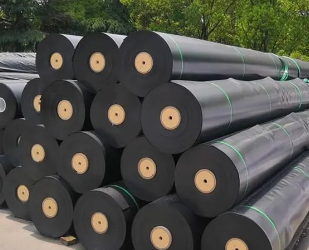- Understanding the Role of Geomembrane Liners in Waste Management
- Innovations in Geomembrane Liners for Water Management
- Geomembrane Liners: A Comprehensive Guide
- The Future of Geomembrane Liners in Civil Engineering
- Geomembrane Liners: Enhancing Landfill Stability
Manager:
WhatsApp:+86 177 0135 2670
Tel:+86 177 0135 2670
Email:marketing@okorder.com
Address:3rd Floor, No.2 Building, No.1 Sanlihe Road
What are the types of geomembranes?
Geomembranes, an essential component in modern engineering and environmental protection, come in various types, each tailored to specific applications and requirements. Among these types are composite geomembranes and high-density polyethylene (HDPE) geomembranes. In this article, we delve into the characteristics, uses, and benefits of these two prominent geomembrane varieties.

Composite Geomembrane: A Blend of Strength and Flexibility
Composite geomembranes represent a sophisticated amalgamation of different materials, each contributing unique properties to the overall structure. Typically, a composite geomembrane comprises layers of Geotextiles or geonet sandwiched between impermeable geomembrane sheets. This layering enhances the geomembrane's performance by combining the strength and puncture resistance of geomembranes with the filtration and drainage capabilities of geotextiles or geonets.
Applications of Composite Geomembranes
Composite geomembranes find extensive use in diverse engineering and environmental applications. One of their primary applications is in containment systems for hazardous waste and industrial effluents. The combination of impermeable geomembranes with filtration layers ensures that potentially harmful substances are securely contained while allowing for efficient drainage and gas venting.
Moreover, composite geomembranes are widely employed in landfill lining systems to prevent leachate seepage into the surrounding environment. The inclusion of geotextiles or geonets helps in distributing the leachate evenly across the geomembrane surface, reducing the risk of localized damage and enhancing overall system performance.
Benefits of Composite Geomembranes
The versatility and performance of composite geomembranes offer several distinct advantages:
1. Enhanced Strength: By integrating multiple materials, composite geomembranes exhibit superior strength and puncture resistance compared to traditional single-layer geomembranes.
2. Improved Drainage: The inclusion of geotextiles or geonets facilitates efficient drainage, reducing the risk of hydrostatic pressure buildup and potential geomembrane damage.
3. Customizable Design: Composite geomembranes can be tailored to meet specific project requirements, allowing engineers to optimize performance and cost-effectiveness.
4. Environmental Compatibility: Composite geomembranes contribute to sustainable engineering practices by providing effective containment solutions for hazardous materials, thereby minimizing environmental risks.
In summary, composite geomembranes offer a versatile and reliable solution for various containment and environmental protection applications, thanks to their blend of strength, flexibility, and drainage capabilities.
High-Density Polyethylene Geomembrane: Robust and Impermeable
High-density polyethylene (HDPE) geomembranes stand out as one of the most widely used geomembrane materials due to their exceptional durability, chemical resistance, and impermeability. Manufactured from high-density polyethylene resins, these geomembranes exhibit superior tensile strength and resistance to puncture, making them ideal for applications requiring long-term performance in challenging environments.
Applications of hdpe Geomembranes
The versatility and reliability of HDPE geomembranes make them suitable for a broad range of applications across various industries:
1. Geomembrane Liners: HDPE geomembranes serve as reliable liners in containment systems for landfills, ponds, and reservoirs, providing impermeable barriers against fluid migration and environmental contamination.
2. Waterproofing Solutions: In civil engineering projects such as tunnels, dams, and canals, HDPE geomembranes are used to waterproof structures and prevent water seepage, ensuring structural integrity and longevity.
3. Aquaculture and Agriculture: HDPE geomembranes are utilized in aquaculture ponds and agricultural irrigation systems to prevent water loss and maintain optimal moisture levels in soil, enhancing crop yield and fish production.
Benefits of HDPE Geomembranes
The widespread adoption of HDPE geomembranes can be attributed to their numerous advantages:
1. Exceptional Durability: HDPE geomembranes offer long-term performance and resistance to environmental factors such as UV radiation, chemicals, and temperature variations.
2. Ease of Installation: Lightweight and flexible, HDPE geomembranes are easy to transport, handle, and install, reducing construction time and costs.
3. Chemical Resistance: HDPE geomembranes are resistant to a wide range of chemicals, making them suitable for containment of hazardous substances in industrial and municipal applications.
4. Low Permeability: With a low permeability coefficient, HDPE geomembranes provide effective barriers against fluid migration, minimizing leakage and environmental impact.

In conclusion, high-density polyethylene geomembranes offer unparalleled durability, impermeability, and versatility, making them a preferred choice for a wide range of containment and waterproofing applications in civil engineering, environmental protection, and agriculture."
- Previous:What are the three types of geotextile fabric?
- Next:What is the lifespan of HDPE geomembrane?
-
2024-06-13Geomembrane is not plastic cloth






